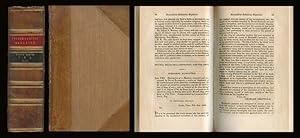About this Item
FIRST EDITION OF THE IMPORTANT PRECURSOR TO ROBERT MILLIKAN'S FAMOUS OIL DROP EXPERIMENT, THIS THE â??BALANCED-DROPLET' EXPERIMENT. In his autobiography, Millikan notes that this paper established the "first definite, sharp, unambiguous proof that electricity was definitely unitary in structure and that it only appeared in exact multiples of that unit." - a scenario that in essence made possible the measurement of the electrical charge. In this paper, Millikan makes "the important discovery that individual drops always carried an exact multiple of the smallest charge measured - this being the first accurate measurement of the charge of the electron" ( Davis, Science in the Making, Volume 3, 10-11). At the time of Millikan's writing, no one had yet obtained a reliable value for this fundamental constant, and some antiatomistic Continental physicists were insisting that it was not the constant of a unique particle but a statistical average of diverse electrical energies" (DSB, 9, pp. 395). "Millikan launched his investigation with a technique developed by the British-born physicist H. A. Wilson; it consisted essentially of measuring, first, the rate at which a charged cloud of water vapor fell under the counterforce of an electric field. Using Stokes's law of fall to determine the mass of the cloud, one could in principle compute the ionic charge. Millikan quickly recognized the numerous uncertainties in this technique, including the fact that evaporation at the surface of the cloud confused the measure of its rate of fall. Hoping to correct for this effect, he decided to study the evaporation history of the cloud while a strong electric field held it in a stationary position. But when Millikan switched on the powerful field, the cloud disappeared; in its place were a few charged water drops moving slowly in response to the imposed electrical force. "He quickly realized that it would be a good deal more accurate to determine the electronic charge by working with a single drop than with the swarm of particles in a cloud. Finding that he could make measurements on water drop s for up to forty-five seconds before they evaporated, Millikan arrived at a value for e in 1909 which he considered accurate to within 2 percent. More important, he observed that the charge on any given water drop was always an integral multiple of an irreducible value. This result provided that most persuasive evidence yet that electrons were fundamental particles of identical charge and mass" (ibid, 396). Here Millikan makes "the important discovery that individual drops always carried an exact multiple of the smallest charge measured - this being the first accurate measurement of the charge of the electron" ( Davis, Science in the Making, Volume 3, 10-11). Millikan recorded the "most probable value of the elementary electrical charge" to have "a weighted mean of 4.65 x 10 (-10) e.s.u. - a significant increase over previously determined values of e, but in excellent agreement with half the value Rutherford and Geiger had obtained for the charge on alpha particles in 1908" (Holton, 1978, 51; Davis, 11). Robert A. Millikan was an American physicist. He received the Nobel prize in 1923 "for his work on the elementary charge of electricity and on the photoelectric effect" (Nobel Portal). CONDITION & DETAILS: London: Taylor & Francis. (9 x 5.75 inches; 225 x 144mm). Complete. [4], viii, [924], 4. Thirteen plates and in-text illustrations throughout. Armorial bookplate on front pastedown (St. John's College, Oxford) and small stamp on the rear of the title page. No other library markings inside or out. Handsomely, solidly, and tightly rebound in three quarter brown calf over cloth boards; a line of slight toning on the front board (see scan); slight scuffing at the edges. Five gilt-ruled raised bands at the spine; gilt armorial devices in the compartments. Gilt-lettered red and black morocco spine labels. Bright and clean. Near fine condition.
Seller Inventory # 688
Contact seller
Report this item
